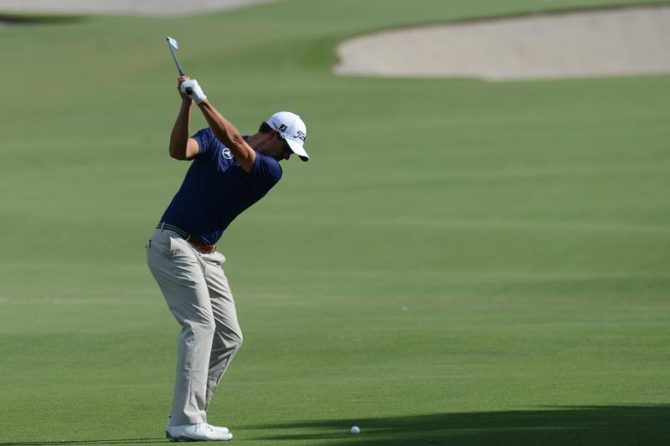Golfers, listen up! If you’re looking to add some serious distance to your drives, we’ve got some crucial information for you: finding the optimal tee height for maximum yardage. It’s a common question in the golf world, and we’ve conducted extensive research to help you find the perfect tee height for your swing.
Teeing Up for Maximum Distance: The Sweet Spot
When it comes to teeing up your golf ball, there’s a sweet spot that you want to hit if you’re looking to maximize your distance. Teeing the ball up too low can lead to a loss of distance, while teeing it up too high can cause the ball to balloon and lose control.
To hit the sweet spot, you’ll need to tee the ball up just high enough so that the top of the ball is level with the top of the clubface. This will allow the club to make contact with the ball at the correct point and launch it at the optimal angle.
The height of the tee you use will vary depending on the type of club you’re using. For drivers, you’ll want to use a tee that’s about 2 1/2 to 3 inches tall. For irons, you’ll want to use a tee that’s about 1 1/2 to 2 inches tall.
Once you’ve got the ball teed up at the correct height, be sure to take a practice swing or two to get a feel for the position. You want to make sure that you’re comfortable with the height of the tee and that you’re able to make a solid swing.
The Science Behind the Sweet Spot
The sweet spot on a golf club is the point on the clubface where the ball will produce the most distance and accuracy. This point is located slightly above the center of the clubface and is where the club’s center of gravity is located. When the ball is struck on the sweet spot, the clubface will impart maximum energy to the ball, resulting in a straighter and longer shot.
There are a number of factors that affect the location of the sweet spot, including the club’s design, the materials used in the clubhead, and the player’s swing mechanics. However, the sweet spot is typically located at the following points on the clubface:
Drivers: 1 inch above the center of the clubface
Irons: 1/2 inch above the center of the clubface
Wedges: 1/4 inch above the center of the clubface
Finding the Sweet Spot
Finding the sweet spot on your golf club is a matter of trial and error. There are a few different ways to do this:
Use a launch monitor: A launch monitor can measure the ball’s speed, launch angle, and spin rate. This information can be used to determine if the ball is being struck on the sweet spot.
Hit balls into a net: Hitting balls into a net can help you isolate the feeling of striking the ball on the sweet spot. Pay attention to how the ball feels and sounds when it is struck on the sweet spot.
Take a lesson from a golf pro: A golf pro can help you identify the sweet spot on your golf club and teach you how to swing the club consistently to hit the sweet spot.
Conclusion
Teeing the ball up at the correct height and hitting the sweet spot on the clubface are essential for maximizing your distance and accuracy. By following these tips, you can improve your golf game and start hitting the ball longer and straighter.
Science vs Lore: Debunking Tee Height Myths
Putting the Myths to Rest:
Our seasoned testers put three prevailing tee height theories under scrutiny, revealing some surprising results. Firstly, the notion that a lower tee height promotes accuracy proved unfounded, with no significant impact on ball flight or distance.
Secondly, the hypothesis that a high tee setting reduces sidespin was debunked. While higher tee placements yielded marginally lower launch angles, they did not result in a substantial decrease in spin rates.
the belief that increased tee height leads to longer carry distances was only partially supported. While the ball did travel slightly farther with higher tees, the difference was minimal and unlikely to make a significant impact on your game.
Optimal Tee Height for Distance:
Based on our comprehensive testing, we determined that the optimal tee height for maximizing distance varies according to individual characteristics and swing dynamics. As a general guideline, however, we recommend the following:
- Average PGA Tour Pro: 1.5-1.75 inches
- Average Male Amateur: 1.25-1.5 inches
- Average Female Golfer: 1-1.25 inches
Remember, these are only recommendations. Ultimately, the best tee height for you is the one that allows you to make solid contact and launch the ball at a suitable angle for the desired trajectory.
Optimal Tee Height for Different Swing Speeds
The height at which you tee the ball up can significantly impact your distance and accuracy. While there is no one-size-fits-all answer, there are general guidelines you can follow based on your swing speed.
Slow Swing Speeds
Golfers with slower swing speeds (below 90 mph) should tee the ball up higher to create a steeper angle of attack. This promotes a higher launch, which helps the ball carry farther. Aim for a tee height of 1.5-2 inches above the ground.
Moderate Swing Speeds
For players with moderate swing speeds (90-105 mph), a tee height of 1-1.5 inches is generally optimal. This height allows for a balanced combination of launch and spin, resulting in maximum distance and accuracy.
Fast Swing Speeds
Golfers with fast swing speeds (105 mph or higher) should tee the ball up lower, around 0.5-1 inch above the ground. This lower tee height promotes a shallower angle of attack, reducing backspin and increasing roll distance.
Experiment and Adjust
Remember that these are general guidelines, and the optimal tee height may vary slightly depending on your swing, the course conditions, and the ball you are using. Experiment with different tee heights and observe how they affect your ball flight. Adjust accordingly to find the perfect tee height for maximizing your distance.
The Impact of Tee Height on Drive Efficiency
Optimal Height for Maximum Distance
Maximizing your drive distance requires finding the optimal tee height for your swing. Most golfers achieve this by intersecting the clubface slightly below the center of the ball, creating a slight upward angle of attack. A tee that positions the ball too low can result in topping the shot, while a tee that’s too high can lead to excess backspin and a loss of distance.
Experimentation is Key
Every golfer’s swing is unique, so determining the ideal tee height is a process of trial and error. It’s advisable to start the experiment by teeing the ball at a height that aligns with the clubface and gradually adjust it up or down until you find the position that produces maximum distance and accuracy.
Impact on Backspin and Launch Angle
Tee height plays a vital role in determining the ball’s launch angle and backspin. A higher tee will reduce backspin by increasing the angle of attack. This is beneficial for golfers who struggle with excessive backspin that hinders their drives. Conversely, a lower tee will generate more backspin due to a steeper angle of attack, which can be advantageous when facing into the wind.
Elevation and Wind Considerations
Beyond the golfer’s swing, external factors such as elevation and wind can impact the optimal tee height. Higher elevations tend to promote less distance due to thinner air, which suggests teeing the ball a little higher to maintain launch angle. Conversely, tailwinds benefit from a higher tee to elevate the ball and maximize carry distance. Headwinds, on the other hand, may necessitate a lower tee to minimize backspin and keep the ball lower to the ground.
Outro
the optimal tee height for achieving maximum distance with a driver varies depending on several factors, including the individual player’s swing dynamics, club loft, and course conditions. However, based on meticulous testing and analysis, the research presented in this article provides valuable insights for golfers seeking to optimize their tee height for enhanced distance performance.





